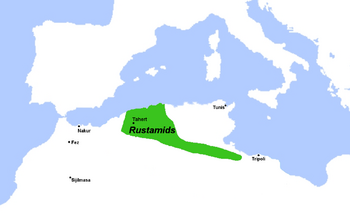Rustamid dynasty facts for kids
Quick facts for kids
Rustamid Kingdom
|
|||||||||||
|---|---|---|---|---|---|---|---|---|---|---|---|
| 777–909 | |||||||||||

Approximate extent of Rustamid control in the 9th century
|
|||||||||||
| Capital | Tahert | ||||||||||
| Common languages | Berber, Arabic, Persian | ||||||||||
| Religion | Ibadi Islam | ||||||||||
| Government | Imamate | ||||||||||
| Imam | |||||||||||
|
• 777–788
|
ʿAbdu r-Rahman ibn Bahram ibn Rūstam | ||||||||||
|
• 906–909
|
Yaqzan ibn Muhammad Abil-Yaqzan | ||||||||||
| History | |||||||||||
|
• Established
|
777 | ||||||||||
|
• Disestablished
|
909 | ||||||||||
|
|||||||||||
| Today part of | Algeria Tunisia Libya |
||||||||||
The Rustamid dynasty (Arabic: الرستميون) was a group of leaders called imams who followed a branch of Islam called Ibāḍī. They were of Persian background and ruled from what is now Algeria.
This dynasty governed as a Muslim theocracy (a government ruled by religious leaders) for about 150 years. Their main city was Tahert (which is now Tagdemt). The Rustamids were eventually defeated by the Ismaili Fatimid Caliphate. Their power reached across central and western Algeria, parts of southern Tunisia, and areas in Libya like the Nafusa Mountains and Fezzan.
Contents
The Rise of the Rustamids
The Ibāḍī movement arrived in North Africa around the year 719. Missionaries, like Salma ibn Sa'd from Basra, helped spread their beliefs. By 740, many Berber tribes in areas like Tripoli and the Nafusa Mountains had become Ibadi.
In 757, a group of four missionaries, including ʻAbd ar-Rahmān ibn Rustam, declared an Ibāḍī imamate (a state led by an imam) in Tripolitania. This first state was short-lived. The Abbasid Caliphate sent an army to stop it in 761, and its leader, Abu l-Khattab Abdul-A'la ibn as-Samh, was killed.
After this, the Ibadi people in Tripolitania chose Abu l-Hatim al-Malzuzi as their next Imām. He also led a revolt but was killed in 772.
A New Capital: Tahert
After these events, the center of Ibadi power moved to Algeria. In 777, ʻAbd ar-Rahmān ibn Rustam was chosen as the new Imām. He was born in Ifriqiya (North Africa), had Persian roots, and was one of the first four founders of the imamate. After him, the position of Imām stayed within his family. The Ibadi people believed this was fair because he didn't belong to any specific tribe, which meant his leadership wouldn't favor one tribe over others.
The new imamate was based in a newly built capital city called Tahert. This city was near what is now Tiaret. Many Ibadi tribes who had moved from Tunisia and Tripolitania settled there. Strong walls and defenses were built around the city. Tahert became a very important stop on the new trade routes that connected sub-Saharan Africa with the Middle East.
Life Under Rustamid Rule
Historians describe the Imām as a humble leader. He would even repair his own house and refused to accept gifts. Citizens would openly criticize him if they felt he wasn't doing his job well. Religious rules were strictly followed and enforced by law.
The Rustamids sometimes fought against the Kairouan-based Aghlabids from Ifriqiya. They had a major battle in 812. However, for most of the time, they managed to live peacefully with each other. This sometimes upset Ibadi tribes living near the Aghlabid border, leading to a few small rebellions.
The End of the Dynasty
After the rule of Abdu l-Wahhāb, the Rustamid state became weaker militarily. In 909, they were easily defeated by the Ismaili Fatimid Caliphate. Many Ibadi people, including the last Imām, fled to the Sedrata tribe in Ouargla. From there, they eventually moved to Mzab, where their community still exists today.
Society and Culture
The Rustamid dynasty was known for being a welcoming place. People from different backgrounds lived together peacefully. This included Christians, other types of Muslims, and followers of different Islamic groups.
The Rustamids were also very interested in learning. They had many scholars and educated people. Some famous ones include ‘Abd ar-Rahman ibn Rustam, ‘Abd al-Wahhab ibn ‘Abd ar-Rahman, and Aflah ibn ‘Abd al-Wahhab.
- ‘Abd ar-Rahman wrote an explanation of the Qur’an.
- ‘Abd al-Wahhab wrote about Islamic law.
- Aflah was skilled in Arabic literature, math, and astronomy.
- Abu al-Yaqzhan wrote about 40 books!
Because they loved knowledge, the Rustamids brought many valuable books from the eastern Islamic world to North Africa. They had important libraries, like al-Ma‘shumah in Tahert and Khizanah Nafusah in Jabal Nafusah. Tahert was even called names like ‘Iraq al-Maghrib or Little Basra, showing how important it was for learning.
The Rustamids also played a big part in spreading Islam in North Africa and West Africa. For about 200 years (from 750 to 950 AD), Ibadi merchants controlled many trade routes. They traveled across vast areas, including Tahert, Wargla, and Ghana. While trading, these merchants also shared the teachings of Islam.
Rustamid Imams
- Abd al-Rahman ibn Rustam (776-788)
- Abd al-Wahhab ibn Abd al-Rahman (788-824)
- Aflah ibn ʿAbdi l-Wahhab (824-872)
- Abu Bakr ibn Aflah (872-874)
- Muhammad Abu l-Yaqzan ibn Aflah (874-894)
- Yusuf Abu Hatim ibn Muhammad Abi l-Yaqzan (894-895)
- Yaʿqub ibn Aflah (895-899)
- Yusuf Abu Hatim ibn Muhammad Abi l-Yaqzan, again (899-906)
- Yaqzan ibn Muhammad Abi l-Yaqzan (906-909)
Family Tree of the Rustamid Leaders
| Family tree of the Rustamid dynasty | |||||||||||||||||||||||||||||||||||||||||||||||||||||||||||||||||||||||||||||||||||||||||||||||||||||||||||||||||||||||||||||||||||||||||||||||||||||||||||||||||||||||||||||||||||||||||||||||||||||||||||||||||||||||||||||||||||||||||
|---|---|---|---|---|---|---|---|---|---|---|---|---|---|---|---|---|---|---|---|---|---|---|---|---|---|---|---|---|---|---|---|---|---|---|---|---|---|---|---|---|---|---|---|---|---|---|---|---|---|---|---|---|---|---|---|---|---|---|---|---|---|---|---|---|---|---|---|---|---|---|---|---|---|---|---|---|---|---|---|---|---|---|---|---|---|---|---|---|---|---|---|---|---|---|---|---|---|---|---|---|---|---|---|---|---|---|---|---|---|---|---|---|---|---|---|---|---|---|---|---|---|---|---|---|---|---|---|---|---|---|---|---|---|---|---|---|---|---|---|---|---|---|---|---|---|---|---|---|---|---|---|---|---|---|---|---|---|---|---|---|---|---|---|---|---|---|---|---|---|---|---|---|---|---|---|---|---|---|---|---|---|---|---|---|---|---|---|---|---|---|---|---|---|---|---|---|---|---|---|---|---|---|---|---|---|---|---|---|---|---|---|---|---|---|---|---|---|---|---|---|---|---|---|---|---|---|---|---|---|---|---|---|---|
|
|||||||||||||||||||||||||||||||||||||||||||||||||||||||||||||||||||||||||||||||||||||||||||||||||||||||||||||||||||||||||||||||||||||||||||||||||||||||||||||||||||||||||||||||||||||||||||||||||||||||||||||||||||||||||||||||||||||||||
See also

- In Spanish: Rostomitas para niños

